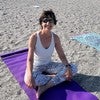Description
About This Video
Transcript
Read Full Transcript
Namaste. Welcome to practice. This will be our Mercury in retrograde solution practice. So let's talk for a moment about Mercury in retrograde. It happens a few times a year, and it appears that Mercury is moving backwards in the sky.
So what does that mean? Mercury is the planet of communication. So it might feel like lines of communication get crossed. There could be delay or confusion, and it can be incredibly frustrating. So what do we do? Well, we slow down. And we pause.
And we try to be a bit more flexible with our choices, with our perspective. Here at yoga anytime, we wanted to emphasize feeling grounded, feeling supported. So this sequence, we will utilize a wall. You will have two blocks and a blanket. All of these props are just there to help support our practice and make us feel more steady at a time where things feel upside down.
So let's get started. Rub your palms together. Take your hands to your heart in Anjali Mudra. You can close your eyes. And for thousands of years, yogis have been practicing what we call Pretipaksha Bavanam.
This idea of changing perspective. So perhaps at a time where things might feel delayed or frustrated instead of fighting against it. We can utilize this time to move more slowly. To move with patients to utilize our tools. Let's chant the sound of ohm, breathing in.
And take a very full breath in and a full breath out. Good. Let's get started. Alright. So, we're gonna start off being very particular about measurements. So scootch your way up towards the wall and come into a dandasana, alright, with your feet against the wall. And then you can take one of your blocks and place it right outside of your mat. Level with your hips.
So it would look like this. Just even with the line of the crease of your hip where the thigh bone meets the pelvis. Yeah? Leave that block there. It'll come into use a couple times throughout the sequence. Once you've got that, we'll come to stand and put our hands against the wall, and they're slightly lower than my shoulders here. And I'm gonna place the balls of my feet about level with my block.
And come into an l shaped movement here. An l shaped pose with hips over heels, and you can slide your hands down so that wrists are in line with shoulders. And then see if you can get even more geometric with this. You might need to bend the knees for a moment. And if lower back or hamstrings are not feeling as open today, keep a slight bend in the knees. Otherwise, working on lengthening out through the legs, and hands can push into the wall, keep the inner arches of your feet lifting. If your legs are straight, keep your kneecaps lifting, and then work to line up the ears with your biceps so that the head isn't dropping too low nor straining at the neck.
We're gonna stay here for five breaths inhale. And exhale for one. Inhale. Aghale two. Even see if you can study your gaze inhale.
XL three. Inhale. Agale four. One more inhale. Agale five.
And then, bend your knees slightly. Walk your feet forward. I'm keeping my feet about hip width apart. Give yourself a moment into Dasana with the feet hip width just gazing at the wall. Full breath in, and full breath out.
And then you'll turn to face sideways left hand comes out, let it land on the wall, about shoulder height with the wrist, lift your right arm all the way up into the air, press down into the feet, get real long through the right side body, and then tip over towards the wall. Now your fingers might brush the wall. They might not depending on how open you're feeling in your side body today. If your fingers are touching the wall, poke your right hip a little bit further out to the right, left arm doesn't need to go completely straight, but you're headed in that direction, pressing down into the feet, and you can even slightly turn the gaze up underneath the right arm. Stay present in your feet, strong in your legs, full breath in, full breath out.
Again, breathing in. Breathing out, and just one more, inhale, and exhale. Inhale your way all the way back up, keeping the right arm lifted and long, and exhale release your right arm down. And let's change sides, taking the right hand against the wall. We can start with that right arm pretty straight, feet are again about hip width, slight bend in the knees here if you need, lift your left arm all the way up, and take your side bend over towards the wall.
Again, fingertips may touch. They may not. If they do, work on pushing away from the wall with your right hand, gaze can turn up underneath the left arm. And then full, full breathing, generous breath right into those ribs, the intercostal muscles that run underneath them, the obliques. All those strong muscles that hold the trunk up.
Give them some space here. Lots of breath. Let's take two more breathing in. Breathing out. And one more breathe in.
Breathing out. Again, pushing down into your feet pressing against the wall, come back up to vertical, reaching up through your left arm, and release your left arm down. And then you'll stay still facing the same side Come a little closer to the wall. Again, feeder about hip width, toes are pointing forward. I'm going to take my right arm back behind me, and the arm starts off about shoulder height straighten out the arm spread out through the fingers, and then take the left arm behind your back and just begin to turn yourself slightly away from the wall here, see if you can carve the head of the arm bone down So that the head of the arm bone fits neatly down into the side body. And then the work here is to work on closing off the ribs, anchor the tailbone, and turn the head towards the left shoulder. And You'll feel this across your chest.
You might feel it down through your bicep or your forearm, but see if you can keep some energy even in the hand, right, pressing the entire palm down. And it's tempting to lean way into the wall, but see if you can stay just slightly away from it. Really getting into those pec muscles. This is your heart line meridian, right, right up through the right middle finger, the center of the forearm, and into the bicep. From here, crawl your right hand up a bit higher so it's more on the diagonal.
It's about a foot maybe 20 centimeters higher. And then this time, turn your head towards your left shoulder and let the head drop down. So chin moves a little closer to your shoulder. And you might feel this one even in your forearm. And even in the pressure of your hands, there's that opening of the fingers.
Full full breathing here. Full breathing. Let's take one more breathe in. Breathing out. And then release, release, release, release, release.
And just stand there for a moment. Give yourself that moment again. We work in patients a bit more slowly here. And then we'll try the other side. So left arm reaches way out behind you, stretching the fingers open.
We start with shoulder height. Meys can slightly bend, toes point directly forward, legs are firm here without locking out, and then you'll start to inch just slightly, slightly turning, turning, turning away from the wall. To that place where you feel the stretch and then recenter yourself. And what I mean by that is ribs close in, tailbone anchors down, right arm can reach behind the back, gaze can turn towards the right shoulder and you're breathing here. And that wall is there for you, and it's actually facilitating more openness across the chest.
So sometimes just having that type of boundary, having that type of steadiness can actually create more openness, not less. Again, it's all just change of perspective, breathing in, and breathing out. And then walk your hand up a little bit higher. Turn the head towards the right shoulder, let the chin come down. Breathe into that, pressing the hand deeply into the wall.
Rotating the torso a little more towards the center of your space away from the wall. One more full breath in. Full breath out. And release, release, release, release, maybe give the shoulders a little bit of a roll. And then you can stay still facing the side.
One hand on the wall, the elbow can be bent here. We're just going to bend the right knee. Catch the right ankle behind almost as if you're setting up for a shiva naturrajasana a dancer's pose. Bring your knees in close to each other and then slide the tailbone forward. Lift the crown of the head up and just feel your way into the quad stretch, kneecap pointing straight down.
Heel coming in close to your bum, just a breath or two here just to feel what's happening with the legs here, with the quads, and then kick the leg forward, give it a little shake. We'll try the other side right away. Bending the left knee, reaching back for the left ankle, organize your hips, organize your knees, knee to knee position, tailbone down, chest up, healed close to the bum and breathing. Feel what's happening with the left thigh, and then kick the leg forward, shake it out, and we'll grab our blocks and our blanket. So you'll take your blanket and place it right up next to the wall with the smooth end towards the wall.
I'm taking my blocks. There'll be one on either side. And then you'll slide your right knee close in towards the wall, foot straight up the wall, push into your blocks, and step your left foot forward into a lunge. And you might need to scooch it a bit more forward just so the heel is directly underneath the knee here. And if this is feeling like too much for you, instead of taking your right knee right up next to the wall, move it a little further forward, and that will lessen the intensity a bit if it's too much for you today. And then begin to walk the blocks back.
And we're gonna start off almost in what what will feel like a virasana. Right? So pushing into the blocks I'm gonna put my hands against the wall, just brace myself there, and push your torso all the way back back against the wall, heal right outside of your right hip. Breathe there, three breaths inhale. Exhale one, inhale. XL two, and this is in your quad, alright, and in your psoas, hip flexor, And that's three. From here, start to drift the hips forward, and you might need to scoot your left foot even a bit further forward.
Hands can stay on blocks if that's what you need. If you'd like to go in a little bit more, arms up, push down into your left heel, stretch up through your arms, and there might even be a bit of a tip backwards, so thumbs come onto the wall. And then you can push your right foot into the wall Work your hips forward any amount more. Breathe there. And you can stop anywhere along the way that feels right for you. And then back up to center, bring your hands down onto the blocks.
We're gonna come out of this carefully. Keep your right foot where it is and slide your left leg back. You'll sit on your left heel and then bring your right leg forward and sit on both heels. Good. Let's try the other side. Take the left knee back into the crease between the wall and the ground or a little further forward if you need.
And then I push into my blocks and I bring the right foot forward. Scoach it to where you need it, and then you'll start to walk your blocks back a bit. Hands come off the blocks. Hands come onto the wall veerasana with that left leg. Getting your whole upper body as close to the wall as possible here.
Sometimes what wants to happen is the right hip poaches out to the right. You can even take the thumb of the right hand into the crease of the right hip and drag it down a bit. And, oh, you'll feel that one. Breathe. And then start to let the hips drift forward again. You can reach for your blocks. Hands can stay on blocks or arms up.
Arms can stay straight up or just a hint of a lean back, thumbs towards the wall, and then work on pushing the left foot into the wall and letting the hips drop. And we breathe. And the wall is there, and it's supporting the opening, breathe in, and breathe out. And coming back up, place your hands back down, left knee stays where it is, hands into block, slide your right leg back, and then bring your left leg forward. And sit on both heels.
And then you can move your blocks off to the side, slide your blanket away. And one more time coming into your dandasana. And then this time, we're gonna do a slightly different measurement with the block. Take the block to the level of about where your tailbone is. Feel that.
Keep the block there if that's helpful. And then you'll flip around and we're working on our l shaped handstand. Now if l shaped handstand is not in your practice today, if going upside down is not working for you today. You can take the exact same variation of l shape that we did in the beginning with hands on the wall, and you'll get all the benefits of that l shaped without taking your feet off the ground. Yeah? Otherwise, hands come down and we're coming into a short downward facing dog, and I'm taking the heels of my hands about level with the front edge of the block.
You might have to work with this a little bit depending on the proportions of your body because we're looking for that 90 degree angle. So it's a down dog with heels towards the wall. It's gonna feel a little shorter than your normal down dog, and step one foot up behind your bum, and then the other foot up behind your bum. And we work on straightening out the legs from here, and it's going to be tempting to try to walk the legs upward and see if you can keep them exactly at 90. And then you'll try lifting one leg up Keep the hips as even as possible there, but reach up through that leg.
And you can look at the wall and then step your right foot down and take your left leg up. And reach reach reach reach reach push your fingertips down, lengthen through your elbows. And then we'll step one foot down, the other foot down, Take your hands closer to you, lift your hips up, let your bum rest against the wall, catch your elbows and just breathe. And that practice of changing our perspective. Yes. It's physiological, but it's also metaphorical.
Right? Everything in our practice can relate to the philosophy of yoga. Change the crossing of your arms and release the arms down, and you'll come down onto your knees. And set yourself up for Shir Sasana headstand a. So I'm spinning around to face the wall. Don't need blocks or blankets for this one.
I'm about six inches, maybe about 10 centimeters away from the wall. From here, I'm on forearms and knees, catching my elbows just to know the exact width of the shoulders and then interlace the fingers. Tuck the toes, lift the hips, down dog on the forearms, and begin to walk the feet forward. I like to keep my head off the ground here pushing into my forearms. And then when you cannot walk the feet forward anymore, drop the crown of your head down, snuggle the back of your head into your hands, and then a little bit of a hop to get hips over shoulders, and you'll reach the leg straight up.
Now the wall is there if you need it. If you're used to headstand without the wall, you can take your feet away from the wall. But what I find sometimes with inversions is that whether I need the wall or not, I like to have it there. I just I I find it just knowing that there's something there to catch me if I do fall. Makes it feel a bit more accessible.
But of course, if you prefer to turn away from the wall, you can do that. But it's just nice to know that the safety net is there if it is needed. And so we'll stay up in our headstand for about one more minute. If you're newer to the practice of headstand, I would encourage you not to stay up too long. Alright? But instead to try to come up, stay for a few breaths, come back down, and then perhaps come back up one more time. If you've been doing headstand for a while, You can work on staying up a bit longer, but, whether you're staying up for a long time or a short time, make sure that the forearm stay active, shoulders are active pulling away from the ears, knit the ribs in, stretch the legs up, It's a very active pose.
And then look at the world upside down. How the ceiling appears to be the floor. The floor appears to be the ceiling. And it's kind of the same thing with mercury and retrograde. It appears that the planet is moving backwards. Things are not always as they seem. And if we stay calm, in the midst of that, perhaps we can ride the wave with a bit more grace and patience knowing that sooner or later, we will find our way back to shore.
Okay. And then bend the knees. And let your feet come down. Give yourself a breath and child's pose. Perhaps even turning the palms up as a gesture of letting go of surrender. And sure there might be unusual forces at work and yet we understand how to work with them.
Rolling up, scooch up real close to the wall. I'm turning sideways towards the wall, taking my left hip right up against the wall, And then laying back, legs come up the wall. Arms can come in a cactus or make more of a shavasana shape. Eyes can close. And just give yourself a moment or so on your back. With your legs up the wall, feet can go limp.
The wall is there for support. Maybe there's a sigh. And then let your breath settle in. Soften into the support. Last few breaths here.
If you need a bit longer with your legs up the wall, you're welcome to stay exactly as you are. If it is time for you to make your way out of it, you can slide your heels down the wall, rolling over onto one side, press into your hands. Come up to sit. Find your seat, taking your hands to your chest. And the wall is right there next to you.
That support is there. We'll chant the sound of home to close. Breathing in. Thank you so much for sharing your practice. Namaste.
Yoga and Astrology: with Ali Cramer
Comments
You need to be a subscriber to post a comment.
Please Log In or Create an Account to start your free trial.













